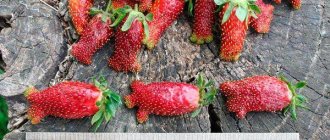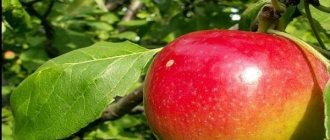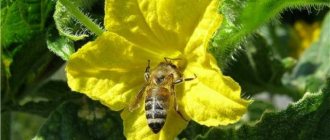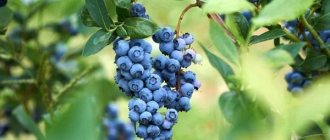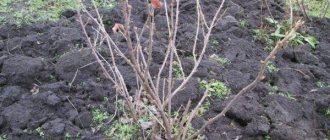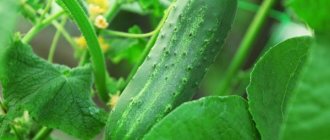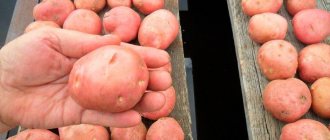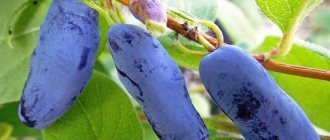Winter ripening apple trees occupy an important place in household plots. I really want one variety to combine winter hardiness, disease resistance, productivity and high taste. Alesya, an apple tree with all these advantages, is one of the sought-after varieties in our country. This crop is used for cultivation in both private and industrial gardening.
Apple variety Alesya.
History of the variety's creation
The Alesya apple tree was bred by breeders from Belarus in the last quarter of the last century. Experts tried to breed a fruit tree from which apples could be well stored in appropriate conditions almost until the next season.
To develop a new variety, breeders crossed two well-known and popular varieties of apple trees - Banana and Belarusian Raspberry.
Alesya received many positive qualities from these varieties, including:
- good taste of ripe apples;
- high quality fruits;
- resistance to adverse weather conditions;
- resistance to attacks by pathogenic microorganisms and pests.
Photo of apple tree Alesya
This variety was registered in the State Register of Belarus at the very end of the last century. The Alesya apple tree was included in the State Register of Russia in 2002.
This apple tree is recommended to be grown in regions with temperate climatic conditions, in particular in the Central and North-Western regions. Although the Alesya apple tree is highly resistant to frost, it is not recommended to grow it in Siberia and the Urals - due to the late ripening period of apples in these regions, the crop will not have time to fully ripen.
Description of apple tree variety Alesya
Apple tree Alesya is a low-growing variety,
at the same time, the tree grows slowly, and adult apple trees can reach no more than 4 m in height. The bark of adult apple trees is smooth, brown in color, while in young trees the bark color is brown. The crown shape of adult apple trees is spherical and quite compact. The foliage of the branches is average, so the crown is well ventilated and there is no thickening observed.
New shoots are formed on this apple tree rather weakly, they grow very slowly - in the first season the growth is no more than 0.9 m, in mature trees - no more than 1.0 m.
The foliage is narrow, elongated, the edges curve inward. The outer leaf plates are a rich emerald color, the reverse side is lighter, with slight pubescence.
The flowers are medium in size, the calyxes are small, the petals are pink.
Apple tree variety Alesya. The most popular industrial apple variety of Belarusian selection - video
Alesya's ripe apples are round and slightly flattened. The skin is medium in density, glossy, its main color is yellow, covered with a rich blush on top, which covers the entire fruit. The pulp is compacted, fine-grained.
On a note!
The taste of Alesya apples is sweet with a slight sourness. Tasting assessment of ripe apples of the Alesya variety is 4.3 points out of 5 possible.
Ripe apples - medium size and weight, about 140 g
. When grown on short rootstocks, the fruit size is even smaller.
Area of application of fruits
These late-ripening apples are collected in the fall and stored so that during the winter they can eat delicious fruits fresh, replenishing the supply of vitamins in the body.
Ripe apples contain a large amount of pectin and sugars, so they can be used to make delicious marmalade, thick jam, jam, or prepare filling for pies and pies.
Advantages of the Alesya apple tree variety
The main positive qualities of this fruit variety include:
- high resistance to major diseases characteristic of other apple trees;
- the harvested crop is stored almost until the next summer season, and many gardeners note that the last apples were eaten the following fall;
- these fruit trees are small in size and compact;
- Fruiting is stable and annual, increasing with the age of the tree;
- The apple tree variety Alesya has high frost resistance;
- low maintenance requirements;
- During the ripening period, apples are not prone to shedding.
No objective disadvantages were found in the Alesya apple tree.
Photo of growing apple tree Alesya
Disease and pest control
The Alesya apple tree is characterized by increased resistance to powdery mildew and scab. If the tree was affected by these diseases, then this indicates improper care of the plant or is associated with the incidence of diseases in other trees nearby. Also, violation of the rules of planting and care can provoke the following diseases:
- Fruit rot . Leads to spoilage of fruits, manifested in the form of hardened pulp and unattractive appearance of apples. To combat the disease, all affected fruits are removed, and then the crown is treated with a solution of iron or copper sulfate.
- Rust. Symptoms: the appearance of brownish and reddish spots on the foliage, which leads to yellowing and death of parts of the tree. Copper sulfate or Bordeaux mixture is used as treatment.
Among the harmful insects that can infect the plant are caterpillars and aphids. If pests are not detected in time or are not dealt with in any way, this will lead to loss of decorativeness of the tree, decreased productivity and stunted growth.
Insecticides are used to control insects:
- Fitoverm;
- Karbofos;
- Aktara.
In order to carry out preventive measures, the tree should be treated with fungicides every year. At the very beginning of spring and at the end of autumn, the soil around the tree and the crown should be sprayed with copper sulfate or Bordeaux mixture.
Apple tree Alesya: features of agricultural cultivation technology
The purchase of seedlings of this variety should be made in specialized nurseries or stores.
In this case, you should pay attention to the following facts:
- The trees should be no more than two years old and there should be no branches. No more than three shoots should extend from the main trunk, which should grow at an angle of 45 degrees (or at a right angle);
- there should be no signs of damage or disease on the bark of the trunk and skeletal branches;
- The roots of the seedling should be strong and elastic, about 30 cm long.
Complete cultivation technology (pruning, care, fertilizing, harvesting and other operations) - video
The planting area should be well lit by sunlight, protected from strong gusts of wind and from stagnant moisture in the soil.
Important!
You cannot plant the Alesya apple tree in a lowland, in a wetland, or where groundwater comes closer to the soil surface than 2.5 m.
Care Tips
There are many tips that will make it easy to care for your apple tree and get a harvest in a short time.
Watering should be carried out during dry season - apply 10-20 liters of water under each tree. Be sure to leave the liquid in the sun.
Top dressing
For fertilizers, use complex compounds. You can replace chemicals with organic matter - mullein infusion or humus.
Loosening the soil
Regularly loosen the soil. Be sure to remove weeds that take away nutrients from the soil.
Seasonal processing
During the season, irrigate the apple tree against pests and diseases. Use preparations based on copper sulfate, folk remedies.
Trimming
In the first year of life, the main trunk is shortened. In subsequent years, shoots, dry or broken branches are pruned.
Mulching
For mulching, use peat and compost. The mulch layer is at least 5 cm. If a nutrient layer is used, it is better not to use fertilizers; thanks to the melt water, the plant will receive everything it needs.
Apple tree planting time
Alesya apple trees are planted in spring or autumn. In this case, spring planting is carried out before the trees begin to flow sap.
Important!
In autumn, the time for planting the Alesya apple tree is chosen taking into account the climatic conditions of the growing region - 25-30 days before the onset of frost.
Planting holes are prepared in advance:
when planting in the spring - in the autumn, and when planting in the fall - 30-35 days before planting.
The soil should be sufficiently loose, fertile, neutral or slightly alkaline, without stagnant moisture or salinity.
Photo of planting an apple tree Alesya
Planting apple tree seedlings
Holes for planting Alesya apple tree seedlings should be dug at a distance of at least 4 m from each other. When planting trees in rows, the row spacing must be at least 3 m. Their depth must be at least 0.5 m, and their diameter must be 0.6 m.
The dug out top layer of garden soil is mixed with humus and mineral fertilizers and each hole is filled 2/3 with such a nutrient substrate.
Photo of apple tree pulp Alesya
A stake is driven into the side of the hole, to which the tree will be tied after planting. And in the center they make a mound of humus, on which an apple tree seedling is placed. Its roots are carefully straightened and the hole is filled with nutrient substrate. Then the soil is compacted, making sure that the root collar is a couple of centimeters above ground level.
Up to 50 liters of water are added to each tree.
Tree care
After planting, the gardener's attention is directed to creating a strong skeleton of the apple tree. In addition, caring for the soil in the garden plays an important role.
Trimming and shaping
Although the apple tree variety Alesya has a spur-type crown, pruning will still have to be done. For a young tree, surgery is needed to form the main skeleton of the tree and subsequently regulate fruiting. The main method of pruning a young apple tree is by shortening. By lightly cutting off part of the length of annual shoots, the crown is branched and rounded. It is necessary to shorten the annual growth if it is more than 30 centimeters. If you prune heavily, the fruiting period will also be delayed.
In an adult Alesya apple tree, the crown is only thinned out, removing broken, diseased branches, as well as hanging and crossing ones. The purpose of thinning will be to transform growth shoots into fruit-bearing ones and prevent the death of fruit branches.
Pollinators
For better fruit set, apple trees need pollination. It can be carried out by insects. For this you will need bees and wasps. But apple trees planted nearby with late ripening periods will also help out.
Watering and fertilizing
After planting the apple tree, it is necessary to mulch the tree trunk circle. This keeps the soil moist and the area free of weeds.
Trees should be watered 4 to 5 times during the summer, adjusting the frequency of irrigation depending on weather conditions. In dry summers, garden crops are watered an additional 3 weeks before harvest, approximately in the first half of September. Each time use up to 60-100 liters per square meter.
When changing mulching, peat or humus is embedded with a shovel to a depth of no more than 5-8 centimeters. In addition, you need to fertilize the grooves next to the apple tree with mullein and bird droppings, dissolving them in water. As for mineral fertilizers, the use of phosphorus-potassium compounds is suitable. They are replaced with wood ash, diluting 50 grams in 10 liters of water.
It is necessary to add nitrogen and potassium fertilizers after the apple tree blooms. This helps to enhance vegetative growth and fruit development. In July, take 15 grams of superphosphate and 7 grams of potassium salt per bucket of water. This fertilizing leads to better crop formation, accelerated ripening of wood and the formation of fruit buds. The fertilizer application rate is a bucket of fertilizer per 2-3 linear meters of the furrow.
Diseases and pests
Scab and powdery mildew are rarely found on the Alesya apple tree variety. But it is possible for the tree to become infected:
- bacterial burn;
- fruit rot;
- rust.
The fruit rot fungus causes apples to spoil and their flesh to harden. To preserve the plant, you need to collect damaged fruits and cut out diseased branches. It is better to spray the tree with fungicides.
Darkening of foliage and shoots at the beginning of summer is associated with bacterial burn. The fight against the disease is carried out by cutting out branches and treating with a solution of copper sulfate. Antibiotics such as Fitolavin are also used.
Among the pests, aphids can be found on apple tree leaves. If there are a lot of ladybugs in the garden, then they themselves will cope with the parasitic insect. Solutions of dandelion roots and laundry soap are effective against aphids.
Codling moth caterpillars cause enormous damage to apple trees. You can save your garden from them with insecticides. To kill butterflies, use containers filled with a mixture of water and kerosene. In the evening, a light bulb is lit above the jars, then the butterflies fly towards the fire and die when they fall into the liquid. To repel butterflies, you can use mothballs, which are hung in bags on trees.
Apple tree Alesya: reviews of those who planted
Vasily, 60 years old, Krasnodar region: In my garden there are several different varieties of late-ripening apple trees, but the main favorite of them has been the Alesya apple tree for several seasons. This apple tree is compact and short in stature, so it has a place even in a small area. I pick apples at the end of September and store them in the cellar. You can eat fresh fruits until the end of spring.
Anya, 50 years old, Belgorod region: One seedling of this late apple tree was given to me by a neighbor in her summer cottage. She already had such an apple tree on the plot, she purchased a couple more seedlings of Alesya, one of which she gave to me. And in the fall and winter she treated me to fragrant sweet apples from this tree. Now I have been collecting delicious harvests from the Alesya apple tree for several years now. I can say that they are stored well until summer, but in April their flesh becomes looser.
Volodya, 49 years old, Moscow region: I decided to plant a late-ripening apple tree on the plot so that I could have my own apples during the winter. The choice fell on the apple tree Alesya. I read that this tree is small, so I planted as many as 3 seedlings, because I thought that their yield was also small, so that the harvest would be enough for my large family. However, the yield from these apple trees turned out to be so large that we put some of the fruits aside for storage for the winter (enough until spring), from the other part my wife makes jam, jelly and marmalade. And we distribute some of it to friends and relatives.
This Belarusian apple tree has firmly taken root in many Russian regions due to its many advantages and the absence of significant disadvantages.
Good yield, the possibility of long-term storage of fruits, resistance to frost and disease - all these qualities were appreciated by Russian gardeners who planted the Alesya apple tree in their garden plots.
Characteristics
- The early fruitfulness of the Belarusian Alesya is not inferior to many foreign varieties. On rootstock 62-369, it begins to bear fruit already 3-4 years after planting as an annual seedling;
- Based on the timing of ripening, the State Register classifies our hero as a late winter species. Harvesting maturity occurs in late September - early October. As already noted, the fruits of the crop can be the last to be harvested in the garden, especially since after ripening they remain on the branches for a long time. The harvested crop must be left to rest so that the apples can accumulate more sugar and acquire their characteristic taste. Therefore, the consumer period will not begin until December;
- annual yield, periodicity in fruiting was not noted;
- productivity is good, increasing every year. Of course, it is still difficult to judge the capabilities of the young crop, but the State Register provides the following indicators - in the Central Black Earth District the yield was 60 c/ha. According to other data, the yield of five- to seven-year-old trees is about 22.0 kg; from nine-year-old trees, 29-32 kg are harvested;
- There is no data from the State Register regarding frost resistance. But breeders claim the variety’s high ability to withstand low temperatures in winter. In this component, our heroine surpasses even the famous Antonovka. True, there is information that in the Yaroslavl region in the winter of 2016 - 2021, when an absolute minimum of minus 39.2 °C was recorded in early January, freezing of apple trees was 3.0 points out of a possible 5.0. But at the same time, a good ability to restore the variety after an unfavorable period was noted;
- this culture has the right to be proud of its immunity. The fact is that Belarusian gardens suffer greatly from scab, so the main task of breeders is to instill in a new crop high resistance to this disease, but not only to it. Our heroine has a high resistance to scab, which is due to polygemism. In addition, the variety perfectly resists powdery mildew, which is confirmed by many gardeners. Thanks to these qualities and timely spring prevention, at the end of the season it will be possible to obtain high-quality and environmentally friendly fruits;
- The plant is also noted to have good environmental resistance to various unfavorable environmental factors. The culture is able to tolerate short-term drought;
- transportable indicators at a high level;
- In terms of shelf life, Alesya is one of the leaders among winter crops. In the refrigerator, the harvest can be stored until April or May without losing its presentation and taste;
- destination: dining. The fruits are consumed in their natural form. The consumption period occurs at the moment when the bulk of the stored apples has already been eaten. In addition, the harvest is processed into tasty and healthy products - jam, jam, applesauce, baking filling, juice and compote.


